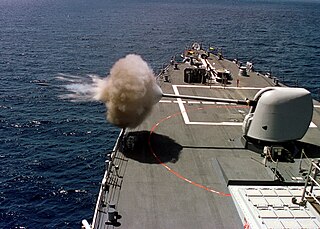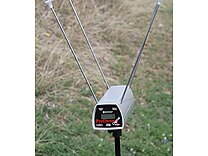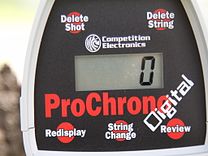
A rifle is a long-barreled firearm designed for accurate shooting and higher stopping power, with a barrel that has a helical pattern of grooves (rifling) cut into the bore wall. In keeping with their focus on accuracy, rifles are typically designed to be held with both hands and braced firmly against the shooter's shoulder via a buttstock for stability during shooting. Rifles are used extensively in warfare, law enforcement, hunting, shooting sports and crime.

A pendulum is a device made of a weight suspended from a pivot so that it can swing freely. When a pendulum is displaced sideways from its resting, equilibrium position, it is subject to a restoring force due to gravity that will accelerate it back toward the equilibrium position. When released, the restoring force acting on the pendulum's mass causes it to oscillate about the equilibrium position, swinging back and forth. The time for one complete cycle, a left swing and a right swing, is called the period. The period depends on the length of the pendulum and also to a slight degree on the amplitude, the width of the pendulum's swing.

A bullet is a kinetic projectile, a component of firearm ammunition that is shot from a gun barrel. They are made of a variety of materials, such as copper, lead, steel, polymer, rubber and even wax; and are made in various shapes and constructions, including specialized functions such as hunting, target shooting, training, and combat. Bullets are often tapered, making them more aerodynamic. Bullet size is expressed by weight and diameter in both imperial and metric measurement systems. Bullets do not normally contain explosives but strike or damage the intended target by transferring kinetic energy upon impact and penetration.

Recoil is the rearward thrust generated when a gun is being discharged. In technical terms, the recoil is a result of conservation of momentum, as according to Newton's third law the force required to accelerate something will evoke an equal but opposite reactional force, which means the forward momentum gained by the projectile and exhaust gases (ejectae) will be mathematically balanced out by an equal and opposite momentum exerted back upon the gun.

Ballistics is the field of mechanics concerned with the launching, flight behaviour and impact effects of projectiles, especially ranged weapon munitions such as bullets, unguided bombs, rockets or the like; the science or art of designing and accelerating projectiles so as to achieve a desired performance.
Muzzle velocity is the speed of a projectile with respect to the muzzle at the moment it leaves the end of a gun's barrel. Firearm muzzle velocities range from approximately 120 m/s (390 ft/s) to 370 m/s (1,200 ft/s) in black powder muskets, to more than 1,200 m/s (3,900 ft/s) in modern rifles with high-velocity cartridges such as the .220 Swift and .204 Ruger, all the way to 1,700 m/s (5,600 ft/s) for tank guns firing kinetic energy penetrator ammunition. To simulate orbital debris impacts on spacecraft, NASA launches projectiles through light-gas guns at speeds up to 8,500 m/s (28,000 ft/s). FPS and MPH are the most common American measurements for bullets. Several factors, including the type of firearm, the cartridge, and the barrel length, determine the bullet's muzzle velocity.
Benjamin Robins was a pioneering British scientist, Newtonian mathematician, and military engineer.

External ballistics or exterior ballistics is the part of ballistics that deals with the behavior of a projectile in flight. The projectile may be powered or un-powered, guided or unguided, spin or fin stabilized, flying through an atmosphere or in the vacuum of space, but most certainly flying under the influence of a gravitational field.

A gunshot is a single discharge of a gun, typically a man-portable firearm, producing a visible flash, a powerful and loud shockwave and often chemical gunshot residue. The term can also refer to a ballistic wound caused by such a discharge.
Internal ballistics, a subfield of ballistics, is the study of the propulsion of a projectile.

Body armor, personal armor, armored suit (armoured) or coat of armor, among others, is protective clothing designed to absorb or deflect physical attacks. Historically used to protect military personnel, today it is also used by various types of police, private security guards, or bodyguards, and occasionally ordinary citizens. Today there are two main types: regular non-plated body armor for moderate to substantial protection, and hard-plate reinforced body armor for maximum protection, such as used by combatants.

In ballistics, the ballistic coefficient of a body is a measure of its ability to overcome air resistance in flight. It is inversely proportional to the negative acceleration: a high number indicates a low negative acceleration—the drag on the body is small in proportion to its mass. BC can be expressed with the units kilograms per square meter (kg/m2) or pounds per square inch (lb/in2).

Gun laying is the process of aiming an artillery piece or turret, such as a gun, howitzer, or mortar, on land, in air, or at sea, against surface or aerial targets. It may be laying for direct fire, where the gun is aimed similarly to a rifle, or indirect fire, where firing data is calculated and applied to the sights. The term includes automated aiming using, for example, radar-derived target data and computer-controlled guns.

The .41 Rimfire Cartridge was first introduced by the National Arms Company in 1863 and was also known as the .41 Short and the .41-100. In most designations like this, the second number refers to the black powder load, though in this case it means "41 hundredths of an inch".

A ballistic pendulum is a device for measuring a bullet's momentum, from which it is possible to calculate the velocity and kinetic energy. Ballistic pendulums have been largely rendered obsolete by modern chronographs, which allow direct measurement of the projectile velocity.
The .408 Cheyenne Tactical is a specialized rimless, bottlenecked, centerfire cartridge for military long-range sniper rifles that was developed by Dr. John D. Taylor and machinist William O. Wordman. The round was designed with a possible military need for a cartridge for anti-personnel, anti-sniper, and anti-materiel roles with a (supersonic) precision range of 2,200 yards. It is offered as a competitor to the most common military NATO long-range service cartridges such as .338 Lapua Magnum and the .50 BMG.
QuickLOAD is an internal ballistics predictor computer program for firearms.
The Aberdeen chronograph was the first portable gun chronograph, an instrument for measuring the muzzle velocity and striking power of a projectile fired by a gun. It was invented in 1918 by Alfred Lee Loomis at the U.S. Army's Aberdeen Proving Ground.

An inertial navigation system is a navigation device that uses motion sensors (accelerometers), rotation sensors (gyroscopes) and a computer to continuously calculate by dead reckoning the position, the orientation, and the velocity of a moving object without the need for external references. Often the inertial sensors are supplemented by a barometric altimeter and sometimes by magnetic sensors (magnetometers) and/or speed measuring devices. INSs are used on mobile robots and on vehicles such as ships, aircraft, submarines, guided missiles, and spacecraft. Older INS systems generally used an inertial platform as their mounting point to the vehicle and the terms are sometimes considered synonymous.
Francis Bashforth was an English Anglican priest and mathematician, who is known for his use of applied mathematics on ballistics.















